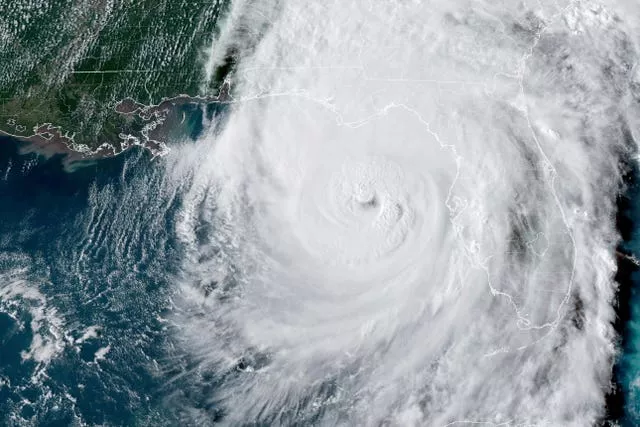Hurricane Helene left an enormous path of destruction across Florida and the entire south-eastern US on Friday, killing at least 35 people across four states, snapping trees like twigs, tearing apart homes and sending rescue crews on desperate missions to save people from floodwaters.
Georgia Governor Brian Kemp said dozens of people were still trapped in buildings damaged by the Category 4 hurricane.

The storm had maximum sustained winds of 140mph (225kph) when it made landfall late on Thursday in a sparsely populated region in Florida’s rural Big Bend area, home to fishing villages and vacation hideaways.
But the damage extended hundreds of miles to the north, with flooding as far away as North Carolina, where a lake used in the movie Dirty Dancing overtopped a dam.
Multiple hospitals in southern Georgia were without power, and one in Tennessee was closed.
Authorities were “having a hard time getting to places” so teams with chainsaws were “working to free up roads,” Mr Kemp told a news conference.
Helene’s devastation comes as climate change exacerbates conditions that allow such storms to thrive, rapidly intensifying in warming waters and turning into powerful hurricanes and typhoons, sometimes in a matter of hours.
“Thank God we’re both alive to tell about it,” Rhonda Bell said after a towering oak tree smashed through the roof of her home in Valdosta, Georgia.
All five who died in one Florida county were in neighbourhoods where residents had been told to evacuate, said Bob Gualtieri, the sheriff in Pinellas County in the St Petersburg area.
He said people who stayed because they didn’t believe the warnings wound up hiding in attics to escape the rising water.
“We tried to launch boats, we tried to use high-water vehicles and we just met with too many obstacles,” Mr Gualtieri said. He said the death toll could rise as emergency crews go door-to-door in the flooded areas.
Deaths also were reported in Georgia and the Carolinas.
Florida Governor Ron DeSantis said the damage from Helene appeared to be greater than the combined damage of Hurricanes Idalia and Debby. “It’s demoralising,” he said.
President Joe Biden said he was praying for survivors as the head of the Federal Emergency Management Agency headed to the area. The agency has deployed more than 1,500 workers, and they helped with 400 rescues by late morning.
In Tampa, some areas could only be reached by boat. Officials elsewhere warned that the water could contain live wires, sewage, sharp objects and other debris.
The hurricane came ashore near the mouth of the Aucilla River on Florida’s Gulf Coast. That location was only about 20 miles (32 kilometres) northwest of where Idalia hit last year at nearly the same ferocity, causing widespread damage.

Cities as far inland as Atlanta were drenched, with just car roofs poking out of the water in some neighbourhoods.
Helene is the third storm to strike the city in just over a year.
Tropical Storm Debby blacked out power to thousands in August, while Hurricane Idalia damaged an estimated 1,000 homes in Valdosta and surrounding Lowndes County a year ago. Now some downtown storefront windows were shattered and store awnings mangled.
Soon after it crossed over land, Helene weakened to a tropical storm, with its maximum sustained winds falling to 70 mph (110 kph). At 11am Friday, the storm was about 105 miles (165 kilometres) north-east of Atlanta, moving north at 32 mph (52 kph) with maximum sustained winds of 45 mph (75 kph), the National Hurricane Centre in Miami reported.
Forecasters expected the system to continue weakening as it moves into Tennessee and Kentucky and drops heavy rain over the Appalachian Mountains, with the risk of mudslides and flash flooding.
A day before hitting the US, Helene swamped parts of Mexico’s Yucatan Peninsula, flooding streets and toppling trees as it brushed the resort city of Cancun and passed offshore. In western Cuba, Helene knocked out power to more than 200,000 homes and businesses as it brushed past the island.
Helene was the eighth named storm of the Atlantic hurricane season, which began June 1. The National Oceanic and Atmospheric Administration has predicted an above-average Atlantic hurricane season this year because of record warm ocean temperatures.







